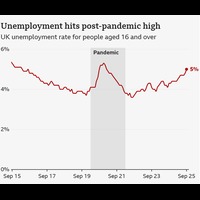
Photo by Loriz E
The UK’s unemployment rate has risen to 5% in the three months leading up to September, according to new data from the Office for National Statistics (ONS) — the highest level recorded since the period between December 2020 and February 2021. The figures indicate a cooling jobs market and have increased expectations that the Bank of England could cut interest rates in December.
The rise was sharper than many analysts predicted, coming in above the 4.9% forecast made ahead of the government’s upcoming 26 November Budget. The increase has been interpreted as a sign of strain in the post-pandemic recovery, as businesses continue to navigate sluggish growth and tighter financial conditions.
At the same time, average wage growth slowed slightly, falling to 4.6% in the third quarter compared to 4.7% in the three months to August. The modest decline in pay growth, combined with the rise in unemployment, has led investors to speculate that the Monetary Policy Committee (MPC) could opt to reduce interest rates when it meets on 18 December.

Danni Hewson, head of financial analysis at AJ Bell, said expectations for a rate cut had increased significantly, but cautioned that “until we see all the chancellor’s workings in black and white, no one is taking anything for granted.”
According to projections by the Bank of England, the unemployment rate is likely to remain close to 5% in the coming years, reflecting a broader slowdown in hiring across several sectors.
Liz McKeown, director of economic statistics at the ONS, said the figures collectively “point to a weakening labour market.”
“Meanwhile, the unemployment rate is up in the latest quarter to a post-pandemic high. The number of job vacancies, however, remains broadly unchanged,” she added.
While the data represents a setback for the government, which has been under pressure to show progress on economic stability, it has simultaneously increased market confidence that policymakers will respond with monetary easing before the end of the year.
Economists say that a December rate cut would aim to stimulate growth amid persistent concerns about slow productivity and declining consumer confidence — though the government insists it remains committed to its long-term fiscal targets.
Overall, the new unemployment figures have painted a picture of a labour market losing some of its earlier resilience, as businesses hesitate to hire and wage pressures ease — both signs that the UK economy is entering a more uncertain phase ahead of the winter months.




